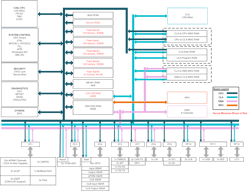Advanced Power Conversion and Energy Management Solutions at TI (Part 2)
What you’ll learn:
- Declining feed-in tariffs and dynamic pricing will drive homeowners to adopt battery storage systems for solar energy storage and energy arbitrage opportunities.
- Precise BMS with millivolt-level accuracy is critical for managing low-cost LFP cells, ensuring safety and longevity as well as maximizing financial returns.
- Edge AI integration enables load disaggregation and improved arc fault detection in solar systems, enhancing safety and system responsiveness without cloud dependency that has historically “bricked” systems when the cloud service gets dropped.
This is the second part of an impromptu chat, between Electronic Design’s technology editor, Andy Turudic, and Henrik Mannesson, General Manager at Texas Instruments, on energy storage and power conversion systems (for Part 1, click here). Unrehearsed, unscripted, and no prep questions, it’s an easy listen.
Residential energy storage is undergoing rapid innovation, driven by the need for efficient solar energy utilization and dynamic grid participation. Henrik emphasizes that as feed-in tariffs decline and market-driven energy pricing becomes prevalent, homeowners will increasingly turn to battery energy storage systems (ESS) to store excess solar generation for use during peak demand, to charge EVs, or to exploit profitable energy arbitrage opportunities.
Unlike automotive batteries, which typically experience the equivalent of around 50 full charge-discharge cycles per year, residential ESS may cycle daily. It thus underscores the importance of robust and precise battery-management systems.
Henrik highlights that modern BMS solutions must deliver cell voltage measurement accuracy down to the millivolt level to reliably determine state of charge (SOC) and state of health (SOH) of battery cells, especially given the widespread adoption of low-cost lithium-iron-phosphate (LFP) cells with their flat discharge voltage curves. Accurate SOC and SOH are essential not only for safety and longevity, but also for maximizing the return on investment, as homeowners may overbuild systems to enable shallower cycling and to optimize financial returns.
Beyond core BMS functionality, Henrik points to the growing integration of edge AI in current and voltage sensing. Edge AI enables advanced features such as load disaggregation—distinguishing between household loads like EV charging and general consumption—and enhances safety through improved arc fault detection.
By running machine-learning algorithms locally on microcontrollers, such as the TI TMS320F28P550SJ MCU+NPU microcontroller (see figure), these systems can reduce false trips and improve responsiveness, avoiding the latency and reliability issues associated with cloud-based solutions.
As the energy transition advances, Henrik asserts that the convergence of high-precision BMS and intelligent edge processing will be pivotal in enabling greater solar adoption, grid flexibility, and economic benefits for both consumers and utilities. These technologies are poised to transform residential energy systems from passive storage to active, profit-generating assets within the smart grid ecosystem.
Please have a listen on your commute, lunch, break, or whenever you have a chance to safely spend about 15 minutes learning where the industry and market is headed in solar and battery electric storage systems.
New episodes of the Inside Electronics podcast air every Tuesday, so feel free to add it to your lunch calendar. Please subscribe to our Power & Analog, Automotive Electronics, and daily newsletters to keep up with the latest articles and learning resources the editors and contributing experts in industry produce for you on Electronic Design.
SHOW NOTES
00:50 – Solar Energy Storage
08:58 – Control
>>Check out this TechXchange for more podcasts
About the Author
Andy Turudic
Technology Editor, Electronic Design
Andy Turudic is a Technology Editor for Electronic Design Magazine, primarily covering Analog and Mixed-Signal circuits and devices. He holds a Bachelor's in EE from the University of Windsor (Ontario Canada) and has been involved in electronics, semiconductors, and gearhead stuff, for a bit over a half century.
"AndyT" brings his multidisciplinary engineering experience from companies that include National Semiconductor (now Texas Instruments), Altera (Intel), Agere, Zarlink, TriQuint,(now Qorvo), SW Bell (managing a research team at Bellcore, Bell Labs and Rockwell Science Center), Bell-Northern Research, and Northern Telecom and brings publisher employment experience as a paperboy for The Oshawa Times.
After hours, when he's not working on the latest invention to add to his portfolio of 16 issued US patents, he's lending advice and experience to the electric vehicle conversion community from his mountain lair in the Pacific Northwet[sic].
AndyT's engineering blog, "Nonlinearities," publishes the 1st and 3rd monday of each month. Andy's OpEd may appear at other times, with fair warning given by the Vu meter pic.
Henrik Mannesson
General Manager, Grid Infrastructure and Power Delivery, Industrial Systems, Texas Instruments (TI)
Henrik Mannesson is general manager of Grid Infrastructure and Power Delivery, Industrial Systems, at Texas Instruments (TI).



